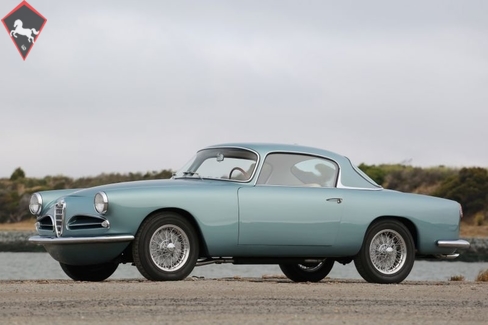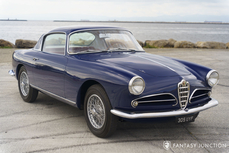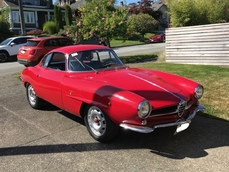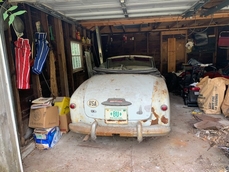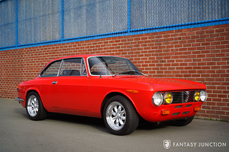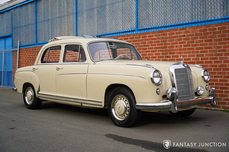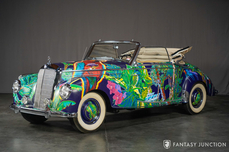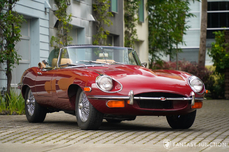Alfa Romeo 1900 C Sprint 1956
General description :
1956 Alfa Romeo 1900C SS Touring
s/n AR1900C10468, eng. no. AR1308*10477*
Verde Oceano with Beige and Biscuit Leather Interior
Alfa Romeo's first all new postwar model featured a number of innovative features including a unit chassis and a 1975cc dual overhead cam inline-4 cylinder engine, and 5-speed transmissions. The newly developed alloy cylinder head offered hemispherical combustion chambers and dual carburetors, while self-adjusting Alfin rear brakes and a variety of different available rear end ratios made the cars formidable performers. Alfa Romeo boasted success in the Targa Florio, the Stella Alpina and the Coupe des Alpes, claiming the slogan “The Family Car That Wins Races.” While most examples were sedans, a handful of special bodied 1900 C Sprint and Super Sprint (CS and CSS) coupes were built, weighing several hundred pounds less and featuring stylish bodies by coachbuilders such as Bertone, Castagna, Touring, Vignale, and Zagato.
Touring Carrozeria’s patented Superleggera (super lightweight) construction employed specifically on the 1900, utilized a formed steel sub-frame, cleverly enveloped by a lightweight aluminum skin. In the Touring design, the refined upper body, delicately garnished pillar construction, and forward swept side glass created a simple elegance for this capable road car. The light and airy upper canopy was all the more beguiling as it cleverly concealed space for two additional passengers or additional luggage in the rear seating area.
According to the original Alfa Romeo sales invoice (included with the car), this stunning and uniquely finished 1900 CSS was commissioned under special order for Sr. Fernando Spada Alvidres c/o Autosports S.A. in Mexico. The invoice specifies the serial number, engine number, and special paint, specifically listing the special exterior paint color “Verde Oceano”, a unique and beautiful light aqua metallic. The color, according to Ferrigno Stefano of Lechler Paint, Italy (the supplier of paint to Alfa Romeo) was used only once on 1900 models. The subtle but enchanting color delivers a light green hue in bright sunlight, which gradually shifts to more of a sea blue color as light fades into sunset. The current owner retains impossibly hard to find original documentation from the Alfa Romeo origin paperwork to period registration papers showing serial number and engine number, covering multiple years into the late 1960s, with additional registration records dated in the 1970s and up to 1983. Records indicate that the car appears to have changed hands only a few times before being purchased by the current owner, who commissioned a comprehensive restoration.
The current owner, a highly respected restoration expert and Alfa Romeo enthusiast, embarked on a comprehensive restoration combining efforts with this car and two other sister 1900s at the same time. The restoration services listing reads like a Who’s Who of automotive restoration, engaging the finest craftsman at Niederst Restorations for all mechanical work, Nick’s Old Cars in Redlands, CA for body and paint, Sihilling in Santa Ana, CA for all chrome work, Quality Interiors in Ventura, CA for the interior, the Borrani factory for all new wire wheels, all instruments restored by Joe’s Speedometer, and all new glass. Specialized Alfa Romeo parts were supplied by sources in England, Germany, and Italy, employing the very best available components while also fabricating dozens of precision period correct fittings, fasteners, linkages, and delicate original features in order to make this Alfa Romeo 1900CSS an exemplary automobile.
The restoration process began with disassembly and tagging of all original components and parts, followed by regular photographs documenting progress. The aluminum body was carefully removed from the lightweight steel sub-structure, repairing all areas that typically exhibit rust or electrolysis due to dissimilar metals being on contact. After the chassis restoration and protective red oxide paint was applied, all steel contact areas were properly “felted” where the aluminum body skin came in contact to allow for future body protection and insulation. Throughout the restoration process, craftsmen were enlisted to make specialized parts including Harry Nicks who personally hand fabricated solid brass grille “eyebrows” specifically fitted to this car. All chrome plating was expertly applied with copper plating and multiple process layers. Hard pressure oil line ends were fabricated from solid brass, lathed, and fit to new copper lines. The often problematic carbon graphite water pump seal was specifically corrected using a custom made aluminum adapter, resurfaced impeller, and a modern rubber lip seal, all reassembled with a new carbon seal. The tachometer drive was custom fabricated using a stainless shaft pressed into the gear assembly, and a custom bushing and seal fabricated for installation in order to deliver smooth, consistent instrument reading.
Further examples of detailed restoration efforts include the steering rebuild. As there are no replacement parts for the Gemmer boxes, several pieces were selected from multiple original sources to find the very best ones to rebuild and install, resulting in a box with somewhat less play. The engine was comprehensively rebuilt using the finest modern components in an effort to improve durability and performance without compromising original appearances and mechanical functionality. The Twin Solex C. 40 PII carburetors were carefully rebuilt often using hand made parts due to the rarity of many critical performance pieces. The transmission, a more robust unit sourced from an Alfa 2600, was dismantled and rebuilt with new syncros, seals, and bearings. During the restoration, the owner decided to convert the car from column shift to floor shift. The clutch and brake pedals were heated and reshaped, allowing for more foot room when operating the pedals. All brakes, suspension, and driveline components were fully disassembled, restored, and either powder coated or painted as needed. The brakes were restored using a special machine and lathing tools specifically developed to true the shoes and turn the specialized drums. All lines and brake hoses were replaced with correct original style components throughout. A new wiring loom was purchased from YNZ Wiring in Redlands, CA and installed using period correct fasteners. All rubber, hoses, trim, and soft gasket material was replaced throughout the car. Linkages, bell-cranks, hood prop and receptacle were among the many detailed parts and features that were handmade to original specifications using stainless or other suitable metals/materials in order to improve the longevity of the restoration.
A brand new windshield was purchased, however the rare rear glass had to be custom molded using the unfortunately scratched original sample. A Canadian glass supplier fabricated four new rear glass pieces, the best of which was selected for this car. The leather interior was expertly stitched and installed along with all trim and Italian-sourced rubber, finishing all the polished aluminum and chrome plated trim beautifully to the aluminum body. The complete restoration exemplifies the finest in craftsmanship and restoration artistry.
Today, the car presents very freshly. The paint is beautifully finished, exhibiting correctly scaled light metallic flake with consistent coverage and excellent final polish. The lustrous high gloss metallic color truly shows the elegance and refinement of the Touring design. The chrome, polished trim, lenses, and all exterior features are exceptionally well fit to the body, including the grille, which is mounted directly to the body without a gasket. The brand new polished Borrani wire wheels, shod with Michelin 165R 400 tires, are accented with chrome plated dual-ear knock offs. The wheels and spokes are beautifully polished, reflecting nicely against the large drum brake castings, giving the car an elegant stance with a touch of competition purposefulness. The Touring emblems, coachwork badges, and delicate trim are exceptional pieces of automotive jewelry, accenting warm silver tones against the unique body color.
The beautifully finished two-tone interior is superb, presented in contrasting beige and biscuit leather, the interior contrasts nicely against the textured black instrument panel, body colored dash, and light colored carpeting. The dashboard and accompanying instruments are beautifully restored and wonderfully laid out displaying gorgeous Italian flair in design, accented by the polished aluminum and wood flat Nardi steering wheel. Overall, the interior exhibits the same excellence and attention to craftsmanship and design as the exterior.
The engine compartment is resplendent with correct factory finishes, exceptional detail, correct hardware, and fasteners, all of which are brought together with mechanical harmony and aesthetic refinement. The textured black castings are uniformly finished with attention to detail and authenticity in every respect. And while many restorations will often be the result of excellent cosmetic efforts, this particular car has also been mechanically updated as well. The trunk is finished with a correct Borrani spare wheel and matching Michelin 165R 400 tire nested into formed tub, while the floor is covered with a correct fluted rubber floor mat. A set of factory tools, tool roll, and jack are housed in the trunk. The underside of the car has been restored with the same attention to detail and authenticity as the rest of the car. Finishes are properly executed with some areas having been powder coated and others painted. The floor is structurally sound, beautifully finished, and representative of a car that has been cared for by owners and properly restored by practitioners of automotive artistry.
On the road, this 1900 delivers a visceral and evocative driving experience. Originally designed as a long-range touring car, many of the contemporary improvements in materials, sealants, and engine rebuilding have further improved the longevity of this innovative platform. The exceptional restoration performed on this car delivers not only enjoyable spritely Italian performance, but also exemplary coachbuilt beauty and elegance. Alfa Romeo 1900s are known to be resilient when properly and spiritedly driven. In the case of this 1900 CSS, the driver will be especially delighted by the performance and reliability experienced in both touring and casual driving. Of particular note is the roomy interior. Unlike many other cars, driver and passengers can engage in conversation and access their personal items, easily stowed in the rear seating area. For vintage touring ease and contemporary driving, it’s hard to beat an Italian GT car of this vintage. Accompanying the car are multiple original ownership documents, the original sales invoice from Alfa Romeo, registrations from previous owners, restoration photos and notation on parts and specifications used during the restoration, an original set of tools, tool roll, and factory jack.
This Alfa Romeo 1900 CSS represents a rare opportunity to acquire an event-eligible Touring bodied Alfa Romeo with astonishingly fresh presentation and great early original documents. The combination of grace and performance, coupled with the contrasting elegant interior and unique exterior color makes this 1900 a great event car candidate and certainly an even more capable concours car. For those who admire handmade coachwork, spacious accommodation, state of the art engineering, and exciting driving, this Alfa Romeo 1900 CSS will handsomely deliver on the slogan of the 1950s “A Family Car That Wins Races.”
http://fantasyjunction.com/cars/2140-Alfa%20Romeo-1900%20CSS%20by%20Touring-1.9%20Liter%20DOHC%20Four-Cylinder
1956 Alfa Romeo 1900 C Sprint is listed sold on ClassicDigest in Emeryville by Fantasy Junction for $425000.
Car Facts
Car type : Car Make : Alfa Romeo Model : 1900 C Sprint Engine size : 1.9 Model Year : 1956 Sub type : Coupé Location : Emeryville
Sold
Seller Information
Sold
People who viewed this Alfa Romeo 1900 C Sprint also viewed similar Alfa Romeo listed at ClassicDigest
Other cars listed for sale by this dealer
About Alfa Romeo 1900 C Sprint
The Alfa Romeo 1900 C Sprint is a classic sports car produced by Alfa Romeo from 1951 to 1953. Here's an overview of its specifications and development history:Specifications:
1. Engine: The 1900 C Sprint was powered by a 1.9-liter inline-four engine, featuring an aluminum block and cylinder head. It had a single overhead camshaft and was equipped with dual Weber carburetors. The engine produced around 100 horsepower, providing impressive performance for its time.
2. Transmission: The car came with a four-speed manual transmission, delivering power to the rear wheels. It featured a floor-mounted gear shifter for precise gear changes.
3. Suspension and Brakes: The 1900 C Sprint utilized independent front suspension with coil springs and a solid axle with leaf springs at the rear. It had hydraulic drum brakes on all four wheels, ensuring reliable stopping power.
4. Design: The 1900 C Sprint featured a sleek and aerodynamic design, characterized by its rounded front grille, prominent fenders, and elegant proportions. It had a two-door coupe body style, offering seating for up to four passengers. The design was influenced by Alfa Romeo's racing heritage, incorporating elements for improved performance and handling.
Development History:
1. Introduction: The Alfa Romeo 1900 C Sprint was introduced as a more sporting variant of the original 1900 sedan. It was designed to cater to enthusiasts who desired a powerful and stylish sports car that could also be used for everyday driving.
2. Lightweight Construction: The 1900 C Sprint featured a lightweight construction compared to the sedan model. It utilized aluminum body panels and had a reduced overall weight, contributing to improved performance and handling characteristics.
3. Limited Production: The 1900 C Sprint was produced in limited numbers, with around 854 units built during its production run. This exclusivity adds to its desirability among collectors and enthusiasts today.
4. Racing Success: The 1900 C Sprint's performance capabilities and handling prowess led to success in motorsport. It competed in various racing events, including the Mille Miglia, where it achieved notable results and helped solidify Alfa Romeo's racing reputation.
The Alfa Romeo 1900 C Sprint is highly regarded among classic car enthusiasts for its beautiful design, impressive performance, and racing heritage. It represents a significant chapter in Alfa Romeo's history, showcasing the brand's commitment to producing elegant yet sporty automobiles. Today, well-maintained examples of the 1900 C Sprint are sought after by collectors who appreciate its rarity, historical significance, and the joy of owning a piece of automotive history.
